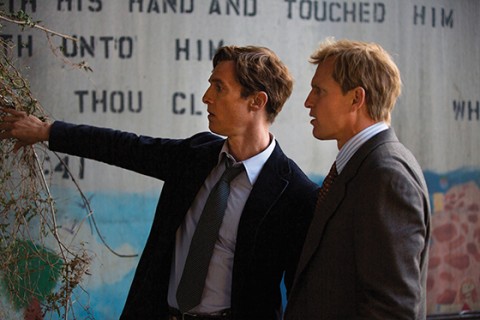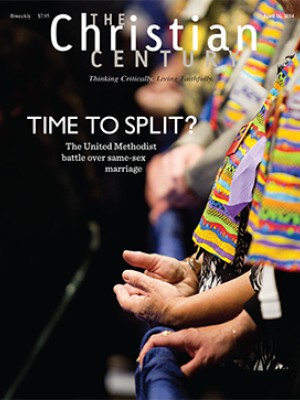Cop car philosophizing

In the last few years, HBO has developed something of a specialty in TV shows set in a decaying southern landscape. Louisiana is the state of choice to represent a land of rich history, myth, and decadence. True Blood was the first to tap this vein with its campy vampire allegory, followed by the more realistic post-Katrina Treme, and now the haunting crime drama True Detective.
True Detective flaunts the southern gothic motif every chance it gets. The story is populated with dilapidated houses, long-abandoned churches, tent revivals, huckster preachers, corrupt politicians, and a populace hiding dark secrets. There is a crumbling plantation-style house so cluttered with the moldering relics of family history that William Faulkner would probably roll his eyes.
Read our latest issue or browse back issues.
The show revolves around the relationship between two ill-matched detectives working on the case of their careers: the ritualized and sexualized murder of a woman in a small bayou parish. The detectives are Rust Cohle (Matthew McConaughey, displaying in riveting fashion his transformation from rom-com pretty boy to serious actor) and Marty Hart (Woody Harrelson). Given the setting, the murder seems highly predictable, tinged with hints of cultish fetishism, misogyny, and misplaced religious enthusiasm. The show elevates the story, however, with surprising narrative techniques and breathtaking cinematography.
The narrative moves between the original investigation of the murder in 1995 and the present. Cohle and Hart are interrogated by two other detectives who are working on a current case that may have links to the 1995 murder. Splitting the narrative this way suggests a more layered mystery. The fact that the contemporary detectives are poring over every detail of the older case suggests that the case was not really put to rest. There are hints of a more pervasive and pernicious evil at work in rural Louisiana.
Despite these hints, the narrative doesn’t go deeper than an episode of Law and Order: SVU. We don’t learn much about why the violence was perpetrated. The victims are just helpless bodies to whom horrible things were done, not fully fleshed people for whom we might come to care. All the hints of supernatural evil and conspiratorial plots are not really about something bigger, but about something more intimate: the relationship between Hart and Cohle.
Their names insinuate an allegorical relationship. Hart is a well-meaning good ol’ boy: a smart detective who thinks with his gut, but who is not prone to pry too closely into his own middle-class existence. Cohle, on the other hand, insists that the world is as worn out and blackened as his name suggests. Prone to existential introspection, he espouses a philosophy of reductive nihilism. One of these monologues so perfectly captures the seeming bravado of “seeing the world as it really is”—set against the backdrop of a tent revival—that I plan to use it with my freshmen classes when I teach about how some popularized theories of religion regard it as folderol for the weak.
This “heart vs. head” or “naïf vs. pessimist” motif starts to break down halfway through the season when it’s evident that Hart’s optimistic embrace of life masks seeds of the same misogyny that afflicts the men he is hunting. And Cohle’s nihilism, it turns out, covers a bottomless well of love and longing suppressed because of personal tragedy. By the final episode (fittingly titled “Form and Void”), it’s clear that the car-ride chatter between Hart and Cohle about whether there is really meaning in the world is the essence of the show. The ritualized killing of women and children was just an object to start their debate.
All of this would be fine if the show weren’t trying to wear a mantle of superiority. In form and style, the show ranks with the best in TV’s renaissance era, and it showcases some of the best acting on television in recent memory. McConaughey and Harrelson breathe such fierce, pulsing life into Cohle and Hart that they are magnetic and unforgettable characters. But the existential heft of the show never exceeds the palaver of a freshmen philosophy class.
If True Detective is renewed for a second season—and given its overwhelming popularity, one assumes it will be—it will come back with a whole new cast, new detectives, and a new story. The filmmaking and acting were so good the first time round, I’m sure I’ll tune in. But let’s hope the writers take a few advanced courses in the liberal arts before they start writing dialogue.






